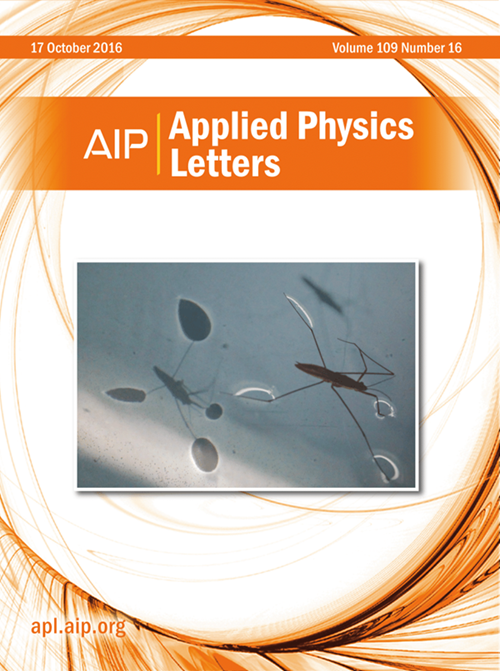HPHT钻石中浅氮空位中心系综电荷态稳定性的掺杂优化
IF 3.5
2区 物理与天体物理
Q2 PHYSICS, APPLIED
引用次数: 0
摘要
金刚石中的氮空位(NV)中心已成为物理学和生物学中重要的量子传感器,因此大量制备高质量、高浓度的氮空位样品已成为迫切需要。随着NV中心靠近表面及其浓度的增加,电荷态的不稳定性会降低相干性并引入额外的噪声。在高压高温(HPHT)钻石中,由于存在不清晰的杂质和不均匀的应变,这一问题进一步复杂化。通过对不同植入样品的光学检测磁共振测试,我们分析了浅NV中心系综的自旋态和电荷态性质。结果表明,掺杂剂量对NV−的数量、电荷量和电荷稳定性有显著影响。我们的研究结果表明,在石墨化开始前过量注入氮作为电子供体有助于稳定浅层NV中心系综的电荷环境。通过控制氮离子注入剂量,优化了光离作用下的电荷态稳定性,在2×1013-8×1013 ions/cm2的最佳注入剂量范围内制备了高质量的HPHT金刚石NV中心系综样品。该方法仅依赖于在HPHT金刚石上氮离子注入和退火,显著降低了传感器样品的成本,极大地有利于量子传感的推广。本文章由计算机程序翻译,如有差异,请以英文原文为准。
Doping optimization of charge state stability for shallow nitrogen-vacancy center ensembles in HPHT diamonds
Since nitrogen-vacancy (NV) centers in diamond have emerged as crucial quantum sensors in physics and biology, the massive preparation of high-quality and high-concentration shallow NV center samples has become urgent and demanding. As NV centers approach the surface and their concentration increases, charge state instability can degrade coherence and introduce additional noise. This problem is further complicated in high-pressure and high-temperature (HPHT) diamonds due to the presence of unclear impurities and inhomogeneous strain. Through optically detected magnetic resonance testing on various implanted samples, we analyzed the spin and charge state properties of shallow NV center ensembles. Our results reveal that the doping dose significantly influences the quantity of NV−, charge, and charge stability. Our findings indicate that over-implanting nitrogen as electron donors before starting graphitization helps stabilize the charge environment of the shallow NV center ensembles. By controlling the nitrogen ion implantation dose, we optimized charge state stability under photoionization and prepared high-quality NV center ensemble samples in HPHT diamonds at the optimal implantation dose range of 2×1013–8×1013 ions/cm2. This method, which relies solely on nitrogen ion implantation and annealing on HPHT diamond, significantly reduces the cost of sensor samples, greatly benefiting the promotion of quantum sensing.
求助全文
通过发布文献求助,成功后即可免费获取论文全文。
去求助
来源期刊

Applied Physics Letters
物理-物理:应用
CiteScore
6.40
自引率
10.00%
发文量
1821
审稿时长
1.6 months
期刊介绍:
Applied Physics Letters (APL) features concise, up-to-date reports on significant new findings in applied physics. Emphasizing rapid dissemination of key data and new physical insights, APL offers prompt publication of new experimental and theoretical papers reporting applications of physics phenomena to all branches of science, engineering, and modern technology.
In addition to regular articles, the journal also publishes invited Fast Track, Perspectives, and in-depth Editorials which report on cutting-edge areas in applied physics.
APL Perspectives are forward-looking invited letters which highlight recent developments or discoveries. Emphasis is placed on very recent developments, potentially disruptive technologies, open questions and possible solutions. They also include a mini-roadmap detailing where the community should direct efforts in order for the phenomena to be viable for application and the challenges associated with meeting that performance threshold. Perspectives are characterized by personal viewpoints and opinions of recognized experts in the field.
Fast Track articles are invited original research articles that report results that are particularly novel and important or provide a significant advancement in an emerging field. Because of the urgency and scientific importance of the work, the peer review process is accelerated. If, during the review process, it becomes apparent that the paper does not meet the Fast Track criterion, it is returned to a normal track.
 求助内容:
求助内容: 应助结果提醒方式:
应助结果提醒方式:


